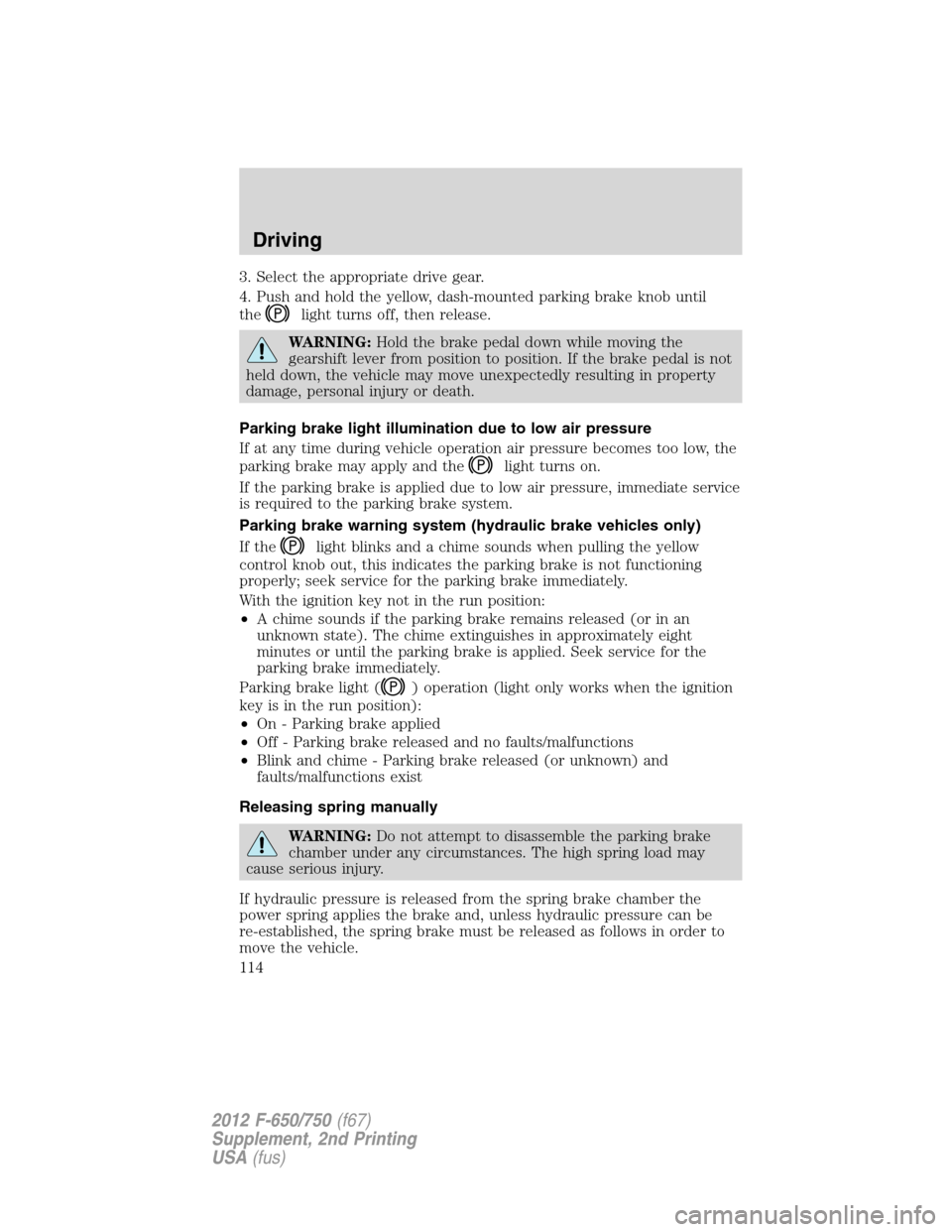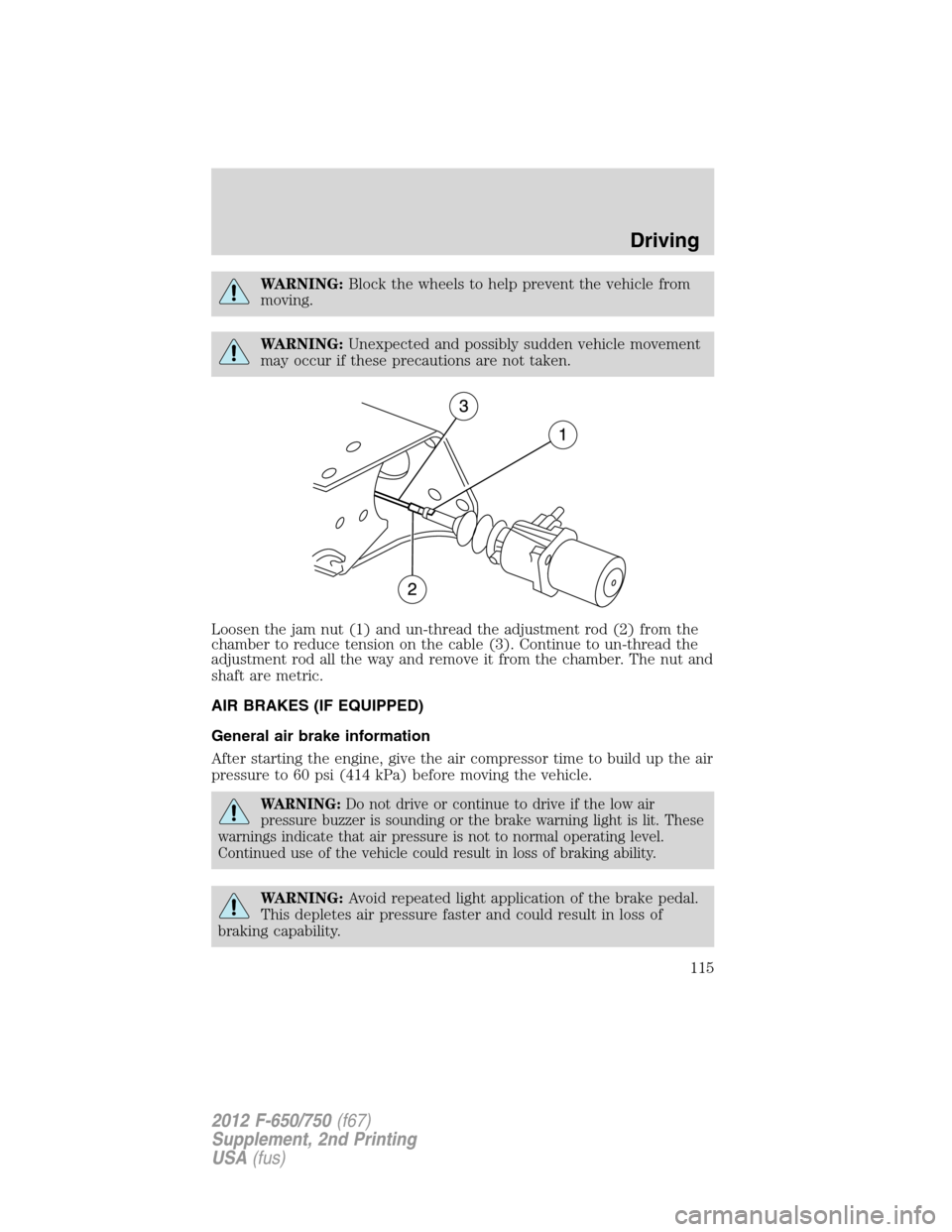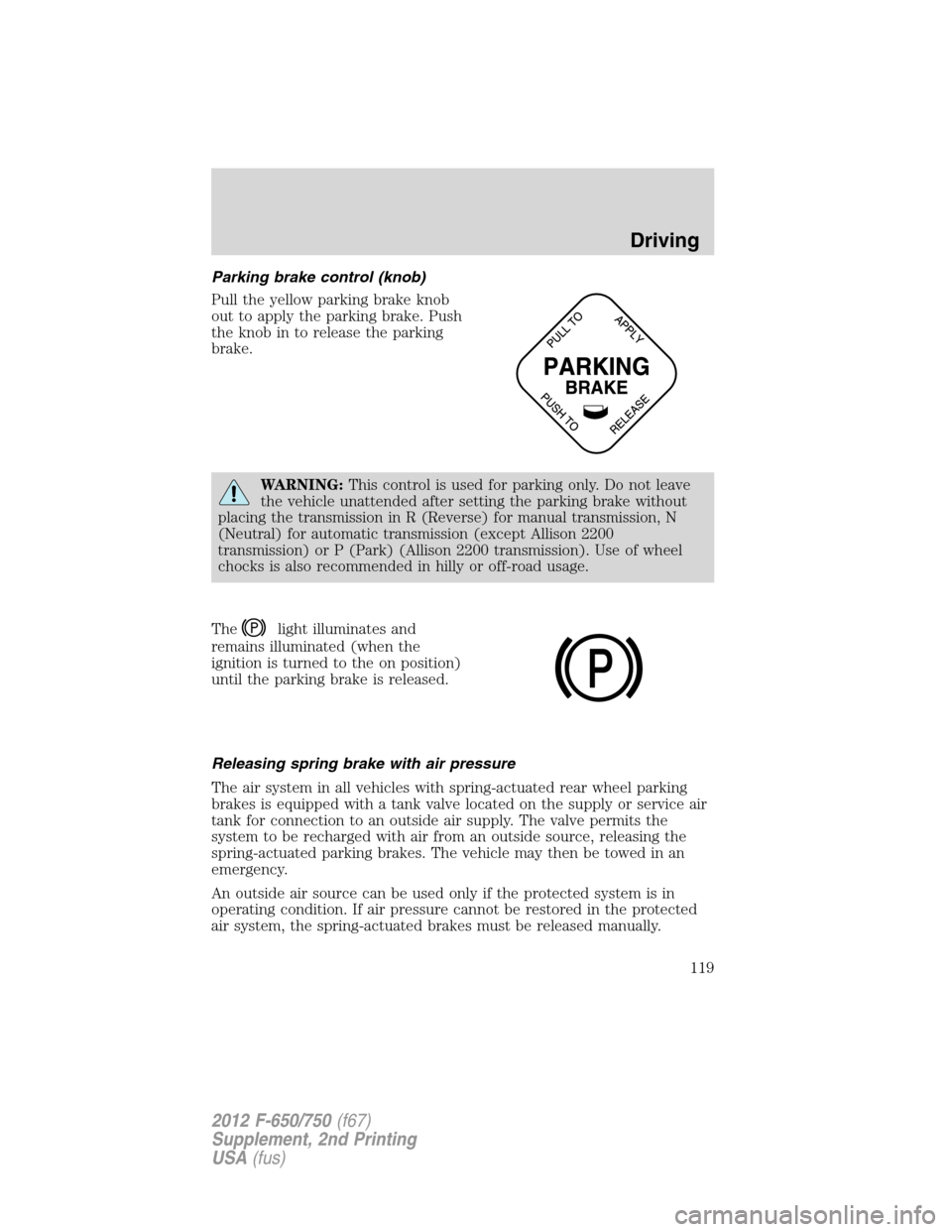2012 FORD F650 warning light
[x] Cancel search: warning lightPage 104 of 306
![FORD F650 2012 12.G Owners Manual 1. Ensure headlamps and all electrical accessories are turned off, the
parking brake is applied and the transmission is in the neutral position
(or P [Park], if equipped).
2. Turn the key to the on po FORD F650 2012 12.G Owners Manual 1. Ensure headlamps and all electrical accessories are turned off, the
parking brake is applied and the transmission is in the neutral position
(or P [Park], if equipped).
2. Turn the key to the on po](/manual-img/11/5078/w960_5078-103.png)
1. Ensure headlamps and all electrical accessories are turned off, the
parking brake is applied and the transmission is in the neutral position
(or P [Park], if equipped).
2. Turn the key to the on position, but do not start the engine.
In cooler weather, the air intake heater may activate the
light. If
the
light illuminates,do notcrank the engine until it goes off.
WARNING:If equipped with an air intake heater, DO NOT use
ether or any other starting fluids. The use of starting fluids
(ether) in an engine equipped with an air intake heater could cause an
explosion and result in property damage and/or personal injury.
3. When the
light turns off, turn the key to the start position;
when the engine starts, release the key.
If the engine does not start after 30 seconds of cranking, allow two
minutes for the starter to cool before trying again. Excessive cranking
may damage the starter.
After the engine starts:
•On some engines, the
light should illuminate after the engine
starts. Allow the engine to idle about three minutes or until the engine
coolant temperature gauge begins to rise. Maintain idle speed until
the
light turns off to indicate the air intake heater has shut off
(approximately six minutes); operating the engine at higher speeds
reduces the effectiveness of the air inlet heater.
•Do not increase engine speed until the oil pressure gauge indicates
normal pressure (as indicated by the arrows); this should be indicated
on the gauge within 15 seconds after starting.
•Idle the engine for three to five minutes before operating with a full
load.
•Try to limit engine idle to 10 minutes; excessive idling reduces fuel
economy.
•When starting a cold engine, increase the engine RPM slowly to make
sure adequate lubrication is available to the bearings.
Starting the engine (gasoline engine only)
Engine starting is controlled by the powertrain control system.
This system meets all Canadian interference-causing equipment standard
requirements regulating the impulse electrical field strength of radio noise.
Driving
104
2012 F-650/750(f67)
Supplement, 2nd Printing
USA(fus)
Page 106 of 306

Starting a diesel engine with the vehicle on a steep grade
When starting a diesel engine when the loaded vehicle is on a grade, the
engine RPM starts to fall slightly when the clutch is engaged; do not
disengage the clutch and try to increase engine RPM as this may damage
driveline components. The engine recovers as the vehicle begins moving.
Cold weather operation
WARNING:Do not use volatile starting aids such as ether,
propane or gasoline in the engine air intake system. Glow plugs
may ignite vapors which can cause engine damage or personal injury.
For best engine operation in temperatures of 32°F (0°C) or lower:
•Make sure the batteries are the correct type and are fully charged.
Check other electrical components to make sure they’re in optimum
condition.
•Use a permanent-type engine coolant to protect the engine against
damage from freezing.
•If your vehicle is equipped with a water-fuel separator, drain it daily.
Fill the fuel tank at the end of daily operation to prevent condensation
in the fuel system.
•Use the proper engine oil and maintain it at its proper level.
•
At temperatures of –4°F (–20°C) or below, it is recommended that you
use a crankcase-mounted coolant heater to improve cold engine starting.
•If operating in arctic temperatures of –20°F (–29°C) or lower, consult
your truck dealer for information about special cold weather
equipment and precautions.
Note:Idling in cold weather does not heat the engine to its normal
operating temperature. Long periods of idling in cold weather can cause
a build-up of heavy deposits of carbon and rust on valve stems causing
them to stick which, in turn, can cause valvetrain damage.
The use of winter fronts, or other air-restrictive devices mounted in front
of the radiator on vehicles with chassis-mounted charge air coolers, are
not recommended unless extremely cold weather conditions exist. Air
flow restriction can cause high exhaust temperatures, power loss,
excessive fan usage and a reduction in fuel economy. If you must use a
winter front, the device should have a permanent opening of at least 120
sq in. (774 sq. cm) directly in line with the fan hub.
Driving
106
2012 F-650/750(f67)
Supplement, 2nd Printing
USA(fus)
Page 109 of 306

may be limited and your vehicle may stall. Water may also enter your
engine’s air intake and severely damage your engine, drive axles or the
transmission (through the breather ports).
Once through the water, always dry the brakes by moving your vehicle
slowly while applying light pressure on the brake pedal. Wet brakes do
not stop the vehicle as quickly as dry brakes.
ENGINE AUTOMATIC SHUTDOWN WARNING LIGHT OR CHIME
(IF EQUIPPED)
This feature illuminates a light in the instrument cluster and/or sounds a
chime indicating that the engine is being shut down in the event of high
coolant temperature, low engine oil pressure, high diesel particulate filter
soot loading or low engine coolant level. In the event any of these
conditions exist, the engine automatically shuts down.
If the engine shuts down, it can be restarted and operated for
30 seconds at a time or until the problem is corrected. Do not attempt to
use this restarting feature to drive the vehicle very far as serious engine
damage could result.
WARNING:In the event of engine shutdown, make sure the
vehicle is safely off the road and the problem is remedied prior
to returning to the road. Failure to remove the vehicle from the road
could result in an accident, causing serious injury or death.
GENERAL BRAKE INFORMATION
All standard equipment brakes are designed to be self-adjusting.
Automatic adjustment, when required, occurs whenever the brakes are
applied and released during forward or reverse operation. Refer to the
Scheduled Maintenance Guidechapter for scheduled maintenance.
Occasional brake noise is normal and often does not indicate a performance
concern with the vehicle’s brake system. In normal operation, automotive
brake systems may emit occasional or intermittent squeal or groan noises
when the brakes are applied. Such noises are usually heard during the first
few brake applications in the morning; however, they may be heard at any
time while braking and can be aggravated by environmental conditions
such as cold, heat, moisture, road dust, salt or mud. If a “metal-to-metal,”
“continuous grinding” or “continuous squeal” sound is present while
braking, the brake linings may be worn-out and should be inspected by a
qualified service technician.
Know the required stopping distances for all driving conditions that may
be encountered. For longer brake lining life, take full advantage of engine
braking power when coming to a stop.
Driving
109
2012 F-650/750(f67)
Supplement, 2nd Printing
USA(fus)
Page 113 of 306

POWER PARK (PARKING BRAKE) OPTION (IF EQUIPPED)
This feature uses a brake chamber mounted on the chassis to power a
spring-applied, hydraulically-released driveline parking brake. It is
controlled by a yellow, dash-mounted parking brake knob.
The Power Park Brake is controlled by the park brake dash-mounted,
yellow knob-type switch. The switch has three positions: apply (out),
neutral (central), and release (in). The switch is spring-loaded to return
to the neutral (central) position after being pushed or pulled.
There is no visual indication at the knob that the park brake is applied or
released; check the instrument cluster. If the
light is illuminated,
the parking brake is applied.
Applying the parking brake
To apply the parking brake, pull the yellow, dash-mounted parking brake
knob. A red light (
) in the instrument cluster should illuminate
indicating that the parking brake has been successfully set.
Note:If the
light blinks and a warning chime sounds when the
control knob is pulled, the parking brake is not functioning properly;
seek immediate service from your dealer. Refer toParking brake
warning systemin this section.
Releasing the parking brake
Note:Read and understand the following steps and perform them
whenever you prepare to drive the vehicle.
Note:The parking brake does not disengage unless sufficient system air
pressure is available.
Automatic transmissions - dash-mounted push button (Allison
3000 Series) and steering column-mounted (Allison 2200 and 2500)
gear selection:
1. With the engine running, press and hold the service brake pedal.
2. Select the appropriate drive gear.
3. Push and hold the yellow, dash-mounted parking brake knob until
the
light turns off, then release.
Manual transmissions - (TTC 7–speed, Eaton/Fuller 5–speed and
6–speed):
1. With the engine running, press and hold the service brake pedal.
2. Press and hold the clutch pedal.
Driving
113
2012 F-650/750(f67)
Supplement, 2nd Printing
USA(fus)
Page 114 of 306

3. Select the appropriate drive gear.
4. Push and hold the yellow, dash-mounted parking brake knob until
the
light turns off, then release.
WARNING:Hold the brake pedal down while moving the
gearshift lever from position to position. If the brake pedal is not
held down, the vehicle may move unexpectedly resulting in property
damage, personal injury or death.
Parking brake light illumination due to low air pressure
If at any time during vehicle operation air pressure becomes too low, the
parking brake may apply and the
light turns on.
If the parking brake is applied due to low air pressure, immediate service
is required to the parking brake system.
Parking brake warning system (hydraulic brake vehicles only)
If the
light blinks and a chime sounds when pulling the yellow
control knob out, this indicates the parking brake is not functioning
properly; seek service for the parking brake immediately.
With the ignition key not in the run position:
•A chime sounds if the parking brake remains released (or in an
unknown state). The chime extinguishes in approximately eight
minutes or until the parking brake is applied. Seek service for the
parking brake immediately.
Parking brake light (
) operation (light only works when the ignition
key is in the run position):
•On - Parking brake applied
•Off - Parking brake released and no faults/malfunctions
•Blink and chime - Parking brake released (or unknown) and
faults/malfunctions exist
Releasing spring manually
WARNING:Do not attempt to disassemble the parking brake
chamber under any circumstances. The high spring load may
cause serious injury.
If hydraulic pressure is released from the spring brake chamber the
power spring applies the brake and, unless hydraulic pressure can be
re-established, the spring brake must be released as follows in order to
move the vehicle.
Driving
114
2012 F-650/750(f67)
Supplement, 2nd Printing
USA(fus)
Page 115 of 306

WARNING:Block the wheels to help prevent the vehicle from
moving.
WARNING:Unexpected and possibly sudden vehicle movement
may occur if these precautions are not taken.
Loosen the jam nut (1) and un-thread the adjustment rod (2) from the
chamber to reduce tension on the cable (3). Continue to un-thread the
adjustment rod all the way and remove it from the chamber. The nut and
shaft are metric.
AIR BRAKES (IF EQUIPPED)
General air brake information
After starting the engine, give the air compressor time to build up the air
pressure to 60 psi (414 kPa) before moving the vehicle.
WARNING:Do not drive or continue to drive if the low air
pressure buzzer is sounding or the brake warning light is lit. These
warnings indicate that air pressure is not to normal operating level.
Continued use of the vehicle could result in loss of braking ability.
WARNING:Avoid repeated light application of the brake pedal.
This depletes air pressure faster and could result in loss of
braking capability.
Driving
115
2012 F-650/750(f67)
Supplement, 2nd Printing
USA(fus)
Page 116 of 306

Periodically check the air pressure
gauge while driving. Pressure should
range between approximately
100–125 psi (690–862 kPa). The air
compressor governor cut-in and
cut-out pressure settings are set at
the factory and are not adjustable.
When air pressure is insufficient
(below 60 psi [414 kPa]), a warning
light illuminates and a buzzer
sounds when the ignition is in the
on position.
This condition may be caused by excessive brake applications depleting
the system air pressure. If this condition occurs, stop driving the vehicle
until the compressor has fully recharged the air system.
WARNING:Do not move the vehicle when the air pressure is
insufficient because the brake system may be inoperative.
Select a gear ratio to help slow your vehicle before descending grades.
Supplement with brakes as required to safely slow the vehicle and avoid
overspeeding the engine.
Air chamber stroke indication
Air chamber push rods have orange stroke indicator markers that warn
when the braking system requires adjustment or repair. The orange
stripe is painted on the air chamber push rod at the slack adjuster stroke
dimension which requires service when visible during brake application.
Air brake inspection and adjustment or repairs should be performed by a
qualified service technician in accordance with the instructions in the
service manual.
Driving
116
2012 F-650/750(f67)
Supplement, 2nd Printing
USA(fus)
Page 119 of 306

Parking brake control (knob)
Pull the yellow parking brake knob
out to apply the parking brake. Push
the knob in to release the parking
brake.
WARNING:This control is used for parking only. Do not leave
the vehicle unattended after setting the parking brake without
placing the transmission in R (Reverse) for manual transmission, N
(Neutral) for automatic transmission (except Allison 2200
transmission) or P (Park) (Allison 2200 transmission). Use of wheel
chocks is also recommended in hilly or off-road usage.
The
light illuminates and
remains illuminated (when the
ignition is turned to the on position)
until the parking brake is released.
Releasing spring brake with air pressure
The air system in all vehicles with spring-actuated rear wheel parking
brakes is equipped with a tank valve located on the supply or service air
tank for connection to an outside air supply. The valve permits the
system to be recharged with air from an outside source, releasing the
spring-actuated parking brakes. The vehicle may then be towed in an
emergency.
An outside air source can be used only if the protected system is in
operating condition. If air pressure cannot be restored in the protected
air system, the spring-actuated brakes must be released manually.
P
Driving
119
2012 F-650/750(f67)
Supplement, 2nd Printing
USA(fus)